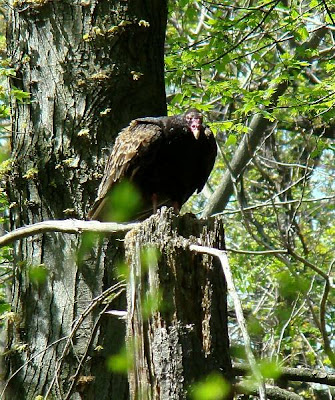
Everytime I had stopped by the Ms nest in the last few days, there wasn't a hawk to be seen on it. I'd begun to worry that they had abandoned it. Therefore today when I got there I was incredibly relieved to see a head sticking up beyond the rim of the nest.
The wind was blowing so hard that the scope was shaking on its tripod. I set it up and began looking through it and focusing. Suddenly I realized that Mom had a white spot on her breast that was brighter than the rest of her breast.
I pulled tighter. Not only did she have a white spot but within the white spot was a little bit of black...WHAT?
Hooray! The Ms have at least one eyass, and maybe more. You never know.
See mom sheltering the little bit of white and black against the wind?

A closer look. Little Bit looks like she is sleeping, snuggled up against Mom's breast. She looks to be up off her haunches, an sleeping upright like a "big" bird.
I didn't want to disturb them so decided to get back in the car and leave for awhile.

Of course when i got in the car, mom got up off the bowl fo the nest and stood on the rim. Where was Little Bit now?

Still there, just to the right of the perpendicular which helps hold the nest together on the other side. See the top of the white fluffy head?

Now look at the positon of the eyass head. While moment ago, the head was left of the skinny upright branch, now there is a head with that branch directly behind it. Did Little Bit move or is there another youngster on the nest?

I start organizing all the junk in the car, so I'm not hit by an avalance when i put on the brakes. I look up. Mom is still there but she is no longer hiding her head behind things. She has turned slightly to look down at the nest.

Mom is now taking an action that I have never seen a Red-tailed hawk do before. She has turned but look at her foot, she's got her talons curled under and it looks like she is pushing the eyass or eyasses (look carefully, are there two little heads being pressed back into the nest?) back down into the nest.
From Robin, "The Blackwater Osprey Cam nest has THREE eggs!"

Photograph by John Santiago
One more photo in from Pat Gonzalez of one of the NYBG hawks for perusal, by way of her friend John.
I was watching the Franklin hawk nest today and what did parent (?Dad?) bring to the nest but --- a sycamore twig complete with pod! Junior looked at the brown dangling pod as dad debated exactly where to put it down in the nest and pecked at it. "Dad! That is NOT a mouse!"
I thought it was interesting. At the Portland nest an green twig was brought to the nest today too, looks like boxwood or the like, not sycamore.











































